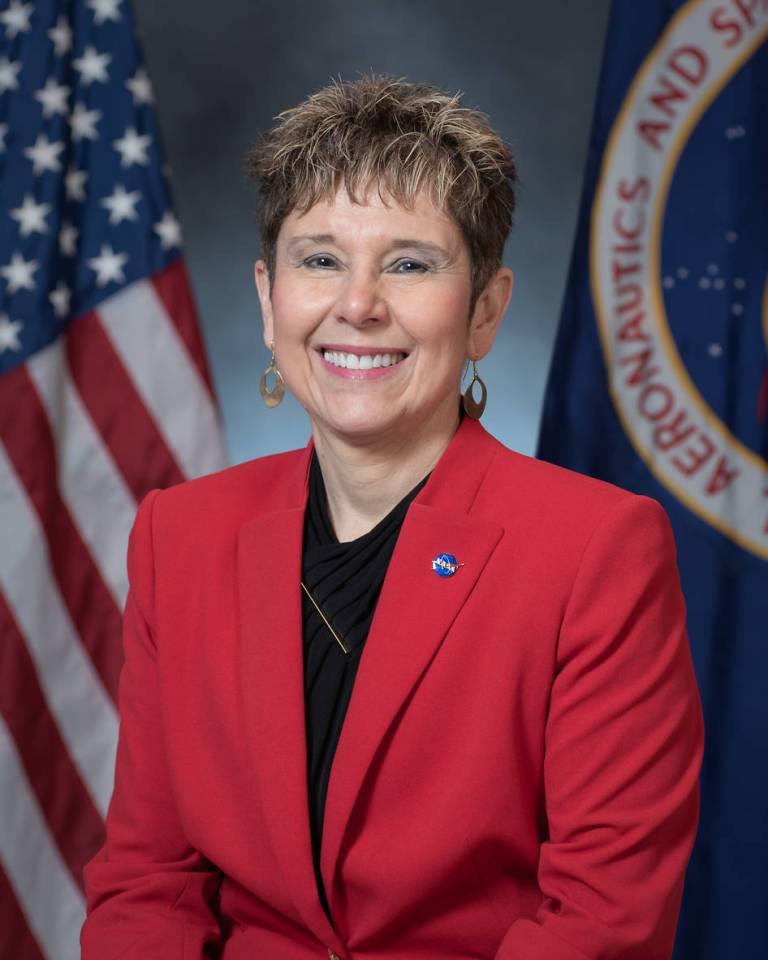
Marla Perez-Davis
Former Director, Glenn Research Center (Jan. 2020–Jun. 2022)
Marla E. Perez-Davis served as center director at NASA’s Glenn Research Center from January 24, 2020 until June 17, 2022. Perez-Davis had been at the center for over 35 years as both a researcher and manager, but she made her mark dealing with the challenges of the COVID-19 pandemic which dominated her time as director.
Perez-Davis, who enjoyed math and chemistry while growing up in a small, rural community in Puerto Rico, discovered the field of engineering while reading an encyclopedia. She was particularly intrigued by chemical engineering, which combined math and chemistry. Her mother supported her academic interest and moved the family closer to the University of Puerto Rico to facilitate her education. NASA representatives recruited Perez-Davis while she was finishing up her Bachelor of Science degree in chemistry. In 1983 she accepted an engineering position in the Storage and Thermal Branch at NASA’s Lewis Research Center (today, NASA Glenn).
At Lewis, Perez-Davis initially studied the stress performance of components for nickel/hydrogen fuel cells. She soon moved to the Electro-Physics Branch where she led studies on power systems for Martian and lunar bases, the effect of those environments on those systems, and the development of protective coatings for solar arrays.
In 1994, Perez-Davis entered the Executive Potential Program supporting the deputy for planning in the Space Flight Systems Directorate. She then managed the center’s support of the Fast Quiet Engine for the High-Speed Research Program. In 1997, Perez-Davis was detailed to the University of Puerto Rico to coordinate collaborative activities between NASA and the university. She returned to the center to assist the chief of Glenn’s Plans and Programs Office.
From 1999 to 2004 Perez-Davis served as chief of the Electrochemistry Branch, which studied a variety of power and propulsion applications of electrochemistry. This was followed by details assisting with the center’s strategic planning and program integration activities. In 2010, she was named director of the center’s new Aeronautics Research Office.
Perez-Davis was named deputy director of the Research and Engineering Directorate and was promoted to deputy director of the entire center in January 2014. With the departure on Janet Kavandi on September 30, 2019, Perez-Davis was appointed acting center director. Weeks later, the agency announced its Mission Support Future Architecture Program (MAP) that would incrementally transition all mission support functions to an enterprise architecture. This activity would occupy much of the center’s leadership throughout Perez-Davis’ tenure. During the winter of 2020 and 2021, the center conducted high-profile testing of the Orion spacecraft in a simulated space environment.
On January 21, 2020, it was announced that Perez-Davis would serve as Glenn’s center director. Just the day before, the Centers for Disease Control and Prevention reported the nation’s first case of COVID-19. The virus spread rapidly over the coming weeks, and on March 6, 2020, NASA performed an agency-wide telecommuting exercise for its staff. Ohio governor Michael DeWine closed a range of institutions over the next ten days, and the agency implemented a multi-stage NASA Response Framework.
Over the next two weeks Glenn quickly moved to through the stages to the framework’s highest level, which was a closure of the center and mandatory telework. The pandemic presented unprecedented challenges for the new director, including ensuring the safety of the staff while maintaining the center’s research and operations from remote locations.
Perez-Davis and Associate Director Larry Sivic began hosting weekly virtual town halls to update the staff on the status of center’s COVID response, continued research activities, and infection rates in the local community. The virtual town halls provided a sense of community among the scattered empoyees. In an unprecedented level of interaction, each week Perez-Davis and Sivic answered questions submitted by employees. She skillfully dealt with queries from both those who did not feel safe at the center and those eager to return to their test cells.
Once the situation stabilized, Perez-Davis worked with health officials to allow closely-monitored numbers of employees temporarily back on site to accomplish specific tests or activities. She withstood pressure to increase access levels until the situation was safe.
Meanwhile, the center continued carrying out its duties remotely. In 2021, Perez-Davis introduced an updated Glenn Strategic Action Plan to improve the center’s flexibility and accessibility as a hybrid workplace. The center also celebrated its 80th anniversary, and Plum Brook Station was renamed NASA’s Neil Armstrong Test Facility. The Research Support Building, a key component of the center’s Master Plan, was opened in the spring of 2022.
With the center safely out of the pandemic, Perez-Davis announced her retirement in May 2022. She retired on June 17, 2022, after 38 years at the center. “It has been a wonderful journey,” Pérez-Davis said, “but it has been all about you—the people who taught me…making me the person I am today.”
Perez-Davis has received numerous NASA awards including the NASA Outstanding Leadership Medal (2012) and the prestigious Presidential Rank Award for Meritorious Executives (2019). She was named Young Career Woman of 1986 by the Lewis Business and Professional Women’s Club. Other awards include the HENAAC Engineer of the Year Award, the 2015 Crain’s Women of Note, the Distinguished Alumni Award from the Alumni Association of University of Puerto Rico Mayaguez, the Women in Aerospace Award for Aerospace Awareness, and the Women of Color Technology Award for Career Achievement.
Addition Resources































